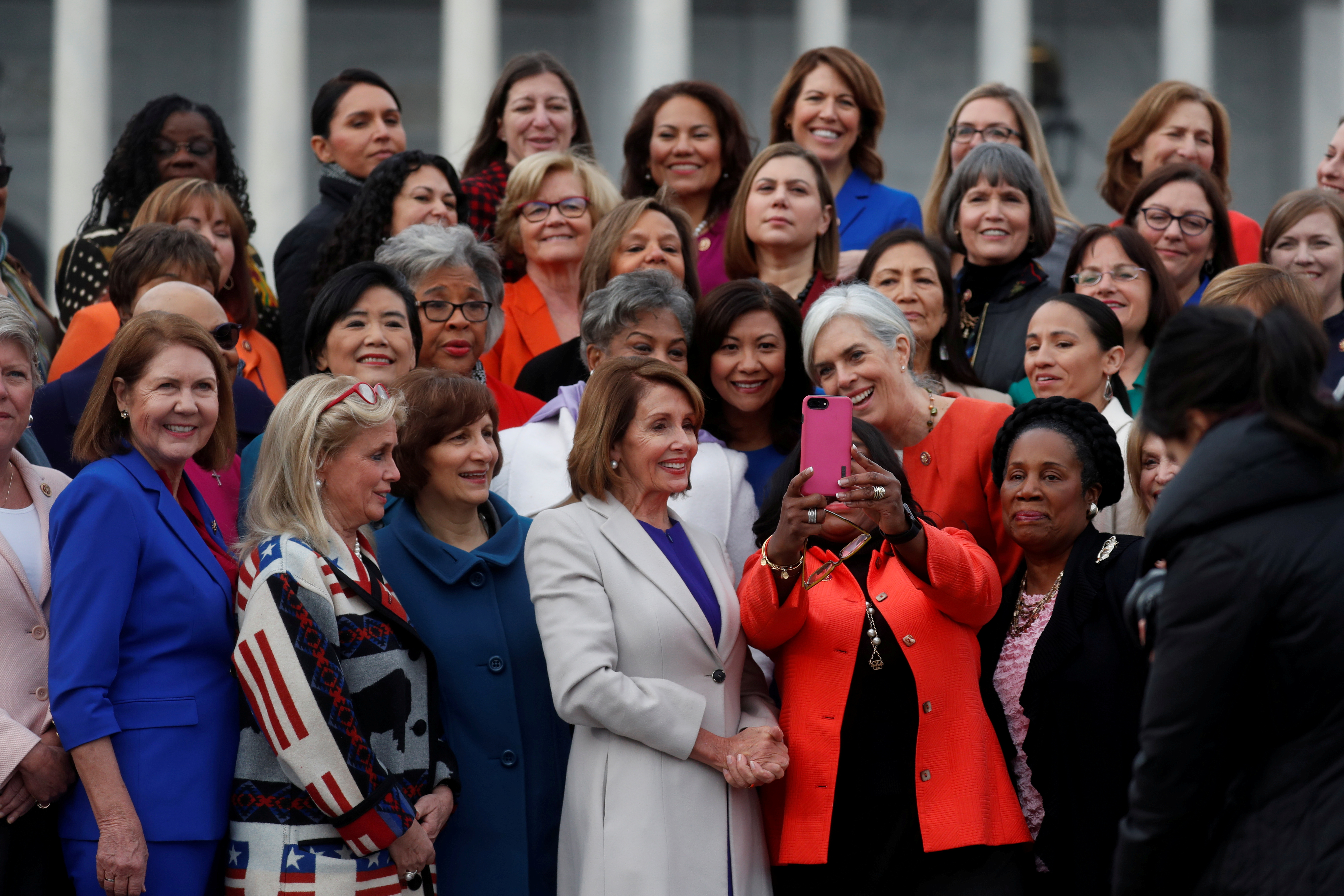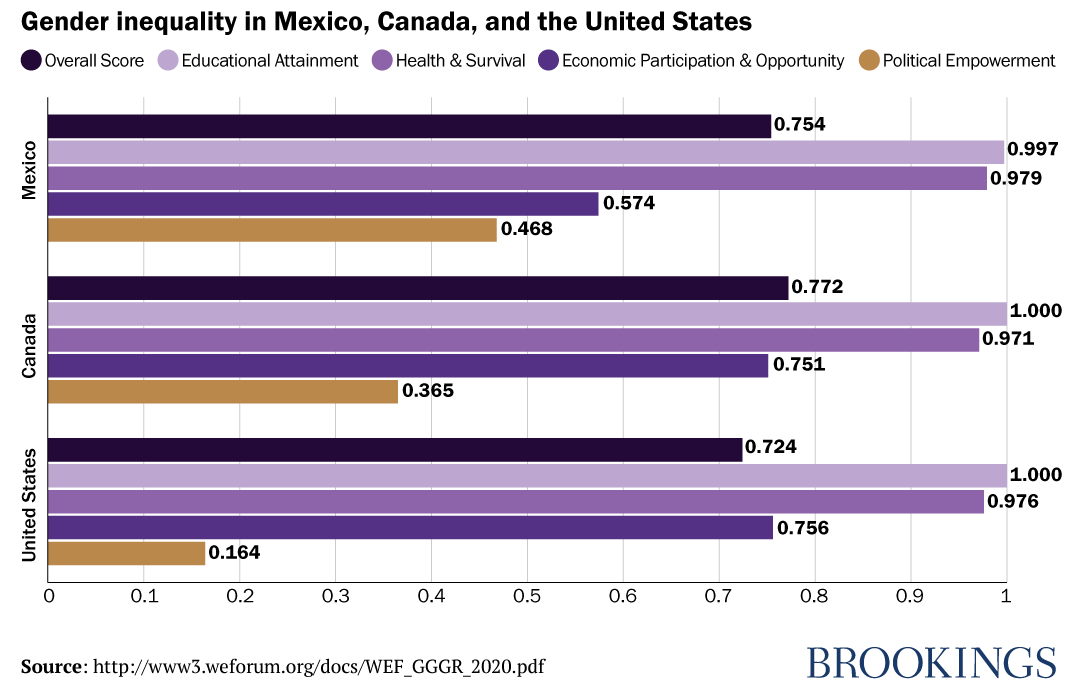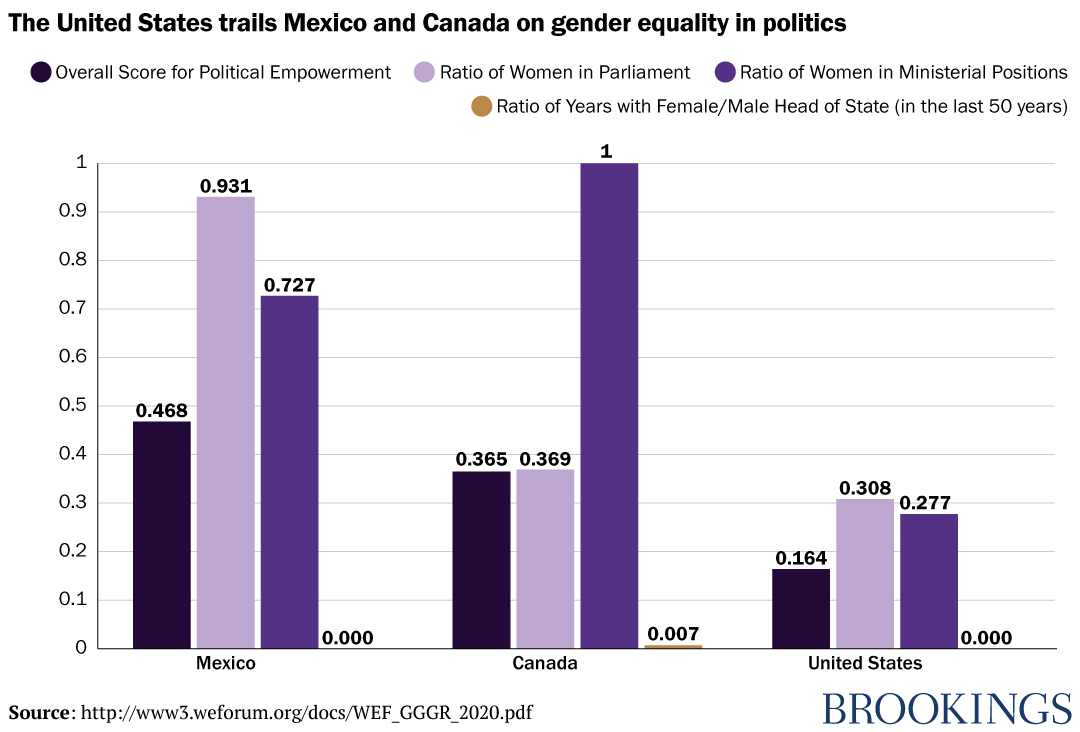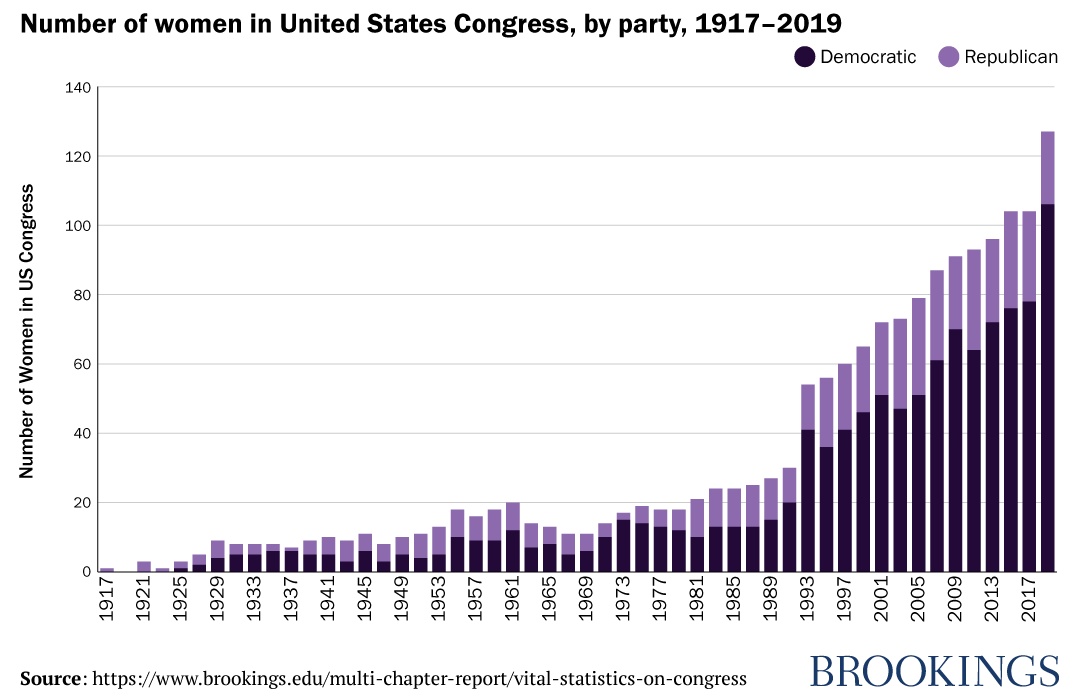
100 years on, politics is where the U.S. lags most on gender equality
A century on from women winning the right to vote in the U.S., our nation has made huge progress on many fronts. But plenty more is needed—and above all in the political sphere. The U.S. compares badly to most other countries in the world in terms of gender equality in politics—including to our nearest neighbors, Canada and Mexico.
Measuring gender equality
The 2020 Global Gender Gap Report from the World Economic Forum ranks progress toward equality in 153 countries around the world. The U.S. is in a disappointing 53rd place, compared to 25th place for Mexico and 19th place for Canada. WEF calculates gender equality in each country based on four equally weighted domains: educational attainment, health and survival, economic participation and opportunity, and political empowerment. WEF calculates the degree of gender equality in each domain, drawing on a range on indicators for each, where each indicator ranges from 0 to 1, with 1 indicating parity.
Here is how the U.S. compares overall and on each on these dimensions to Canada and Mexico:

All three countries have achieved gender equality, or very close to equality, in education and health. (In fact, gender inequalities especially in education now go the other way, which does not influence the WEF scoring system). The U.S. and Canada score similarly, and much higher than Mexico, in terms of economic equality. But in terms of political empowerment, Mexico leads the three, followed by Canada, with the U.S. trailing well behind.
Equality in politics: The U.S. lags behind
Gender equality in the political domain is calculated by WEF using three indicators: the ratio of women to men in terms of years in executive office (prime minister or president) over the last 50 years; the current ratio of women to men in parliamentary positions; and the current ratio of women to men in ministerial positions.
All three North American nations score poorly on the first indicator. Neither Mexico nor the U.S. has had a female political leader, and Canada was led by a woman for just six months (Avril Campbell in 1993). In the U.S., 2016 was the first year when voters even had the chance to vote for a female presidential candidate from one of the major parties.

But as the figure shows, parliamentary representation in Mexico is now essentially equal, and ministerial representation is close behind, at 42 percent female. Both Canada and the U.S. do much less well than Mexico on the parliamentary measure, with women accounting for just one in four legislators. But Canada now excels in terms of ministerial representation, with Justin Trudeau making good on his electoral promise to choose a gender-equal cabinet.
Scoring poorly on all three metrics, the U.S. falls into the bottom half of the global league table for gender equality in the political sphere, trailing behind, for example, the Philippines, India, South Korea, and the United Arab Emirates.
By my calculations, if the U.S. matched Mexico’s political empowerment score, it would jump from 53rd to 6th place in the world for gender equality (with an overall equality score of 0.80), beating out New Zealand, Denmark and Canada. For the U.S., politics is the biggest challenge—but also therefore potentially the biggest opportunity.
Getting closer to gender equality in politics: Congress
Improving the representation of women in Congress is a clear imperative. The last three decades have seen rapid gains on this front:

But even now there are still three men for every woman in the U.S. Congress. It is also notable that the increase is skewed heavily to the Democrat side of the aisle, where the proportion of women has increased from 3.7 percent in 1991 to 19.8 percent in 2019, compared to a rise from 1.9 percent to 3.9 percent for Republicans. If the Republican Party had similarly increased the proportion of Senators and members of the House during this time, overall female representation would now be at 30 percent, rather than 24 percent, and would lift the U.S. from 53rd place to 43rd place on the global league table.
A step-change in female representation is needed to get close to equality within any reasonable timetable. But how? Mexico’s progress is the result of intentional policy changes. Since 2014, the Mexican constitution has required gender parity among candidates from all political parties for positions in the federal Chamber of Deputies and Senate (as well as and state congresses). The resulting transformation in representation is proof that “quota laws work,” according to Sofia Alessandra Ramirez from the Council on Foreign Relations.In fact, more than half the countries in the world now use some form of quota system to increase female representation. There is no evidence of a drop in the quality of candidates or legislators. If anything, quotas seem to improve the skills of leaders by, as one Swedish study brutally put it, reducing the number of “mediocre men.”
Quotas in politics are a great idea, but even if such a law could be passed in the U.S. it would be struck down as unconstitutional by the Supreme Court. Nothing, however, is to stop the major political parties from adopting such quotas themselves—like parties in many other countries. Anisa Somani suggests that some public funding of political parties could be tied to the adoption of such quotas, an excellent proposal.
Replacing the current “winner takes all” voting system with more representative approaches such as ranked choice voting or multi-winner districts would also result in greater female representation, among many other reasons for their adoption.
Getting closer to gender equality in politics: Cabinet and president
The fastest way to improve the U.S. ranking would be to for either President Trump or President Biden to follow Trudeau’s lead and appoint a balanced cabinet. Overnight, the global standing of the U.S. in terms of gender equality would be dramatically improved. Another area where progress is needed (and has gone backwards since 2016) is in the proportion of women in advisory positions, as Kathryn Dunn Tenpas argues in her essay in this series.
But the biggest prize of all, of course, is the White House. Although WEF gives each of the four main domains—economics, health, education, and politics—an equal weight, the sub-indicators for each are weighted differently. For the political empowerment score, most weight goes to the head-of-state indicator. And here of course the U.S. gets the lowest score possible: zero. By comparison, many countries closer to the top of the gender equality table have had women as political leaders for many of the last fifty years, including Iceland (22 years), Norway (16 years), Germany (14 years), and the United Kingdom (14 years).
Simply electing a woman as president would therefore transform the position of the U.S. on the international league table for gender equality. By my calculations, if Hillary Clinton had become a two-term president in 2009, the U.S. would be 36th in the world—not high enough perhaps, but a lot higher than 53rd.
Quantifying gender inequality
The World Economic Forum is not the only game in town: there are many other indices of gender equality, including internationally-focused ones produced by the European Institute for Gender Equality the United Nations and the OECD. Each have their strengths and weaknesses, and each rest on different assumptions about what matters most and how progress should be quantified. Some include measures of time use, rates of domestic violence, tax treatment, civil liberties, and so on. Some focus more on absolute measures, while other highlight the relative position of women and men.
As a general proposition, countries that are more economically developed are typically closer to gender equality. In many of these countries, women have overtaken men on some fronts, such as education, while still at a disadvantage in many other areas, such as politics.
What would John Stuart Mill say?
Fifty years before the U.S. granted women the vote, John Stuart Mill argued in The Subjection of Women for “a principle of perfect equality.” He considered that “the most vitally important political & social question of the future, [is] that of the equality between men and women.”
But how will we know when “perfect equality” has been achieved, when the “subjection” of women has ended? Mill, like most of his contemporaries, was focused on achieving equality for women in law, and especially with the right to vote. Like his intellectual partner and wife. Harriet Taylor Mill, he hoped that women’s suffrage would pave the way to equality in other walks of life.
By and large this was an accurate prediction. Getting the vote was indeed a vital first step to getting many other social, legal and political rights for women. But even now, “perfect equality” has not been achieved—and in the U.S., especially in the sphere of politics itself.
The fight for equality began with politics, and specifically with the right to vote. After ten decades of significant social, cultural, and economic progress, the biggest challenge is once again in the political arena. Now, the need is for much greater representation of women in politics—including in the highest office in the land.
I would like to thank Chris Pulliam for providing valuable research assistance.
This piece is part of 19A: The Brookings Gender Equality Series. Learn more about the series and read published work »



